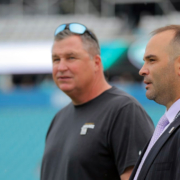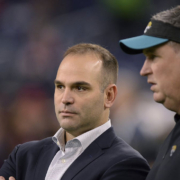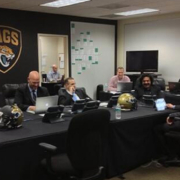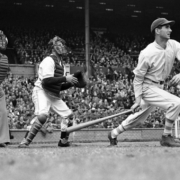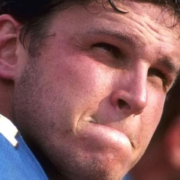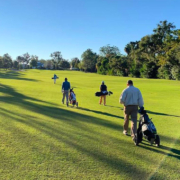Draft Shows What Jaguars Think of 2020
“Read your article on the draft today,” my friend ‘Wooly’ texted me last Sunday. “Really liked it but thought you were holding something back,” he added.
It’s not that I was holding anything back, I told him. But the Jaguars clearly have their own ideas about how this team should be built and what it will be able to do.
And you can agree with that or not.
“I think you have to expect them to lie,” season ticket holder ‘Ghost of Chuck’ said as we talked about what the Jaguars said they were doing and what they’re actually doing.
While ‘lying’ might be a bit harsh, there’s no question that the days and weeks leading up to the draft are a time of, let’s say ‘disinformation’ in the NFL.
When you look at what the Jaguars did with the draft and what they said afterwards, it gives a pretty clear picture where Head Coach Doug Marrone and General Manager Dave Caldwell think this team can compete.
When asked if he thought about taking an offensive lineman with the ninth pick in the first round, Caldwell gave a direct and pretty revealing answer.
“We did, but the one we may have considered was probably gone at the time.” In the top eight picks before the Jaguars were on the board, the only offensive lineman taken was Georgia’s Andrew Thomas, a tackle, selected fourth by the Giants.
Cleveland took Alabama’s Jedrick Wills, another tackle, right after the Jaguars at the tenth spot. Tristen Wirfs another tackle from Iowa went 13th to Tampa Bay. Southern Cal’s Austin Jackson went to Miami 18th, Cesar Ruiz from Michigan and Isaiah Wilson of Georgia were also taken in the first round.
So elite offensive linemen were available in this draft, but the Jaguars didn’t select any at that position until Ben Bartch from Division III St. John’s of Minnesota in the fourth round. Bartch looks to have great potential but even the Jaguars admit he’s a ‘project.’
Clearly this draft and the renegotiated deal they made with Andrew Norwell sends the current Jaguars offensive line a message: “You’re it, get better.” Doug Marrone admitted as much.
“I think we have some good competition behind those guys right now,” Marrone said while the draft was going on. “Will Richardson, we have to get him locked him into a position. Tyler Shatley has done a good job for us I think those players have a lot on their plate to make sure they improve. We’ve said that. We really think they’re going to make a big jump.”
In other words, as my friend and colleague Mike DiRocco said in response to a question about the lack of offensive line picks, “They clearly have more confidence in the offensive line than you or the media do.”
Caldwell didn’t use any of his “ammo,” as he put it, of twelve picks to move up or back to get the players they wanted. According to him, they didn’t have to.
“We didn’t acquire picks to get less players, we acquired picks to get more players, and like I said there were so many players that we liked that at the end of it, we were like, ‘I wish I had a couple more picks in the seventh round.”
He admitted they’d have been happy to take wide receiver Laviska Shenault Jr. in the first round if they didn’t think he’d be there when they selected in round two.
“Should we go get Laviska?” Caldwell said about the conversations in the draft room when wide receivers started coming off the board. “We thought about it and I think we just said, ‘Let’s stick to the philosophy of this year’s draft. I’m not saying that’s every year’s draft. Next year, it may be different.”
A deep receiver class and Shenault falling “by the wayside a little bit,” allowed the Jaguars to wait and take him with the 42nd selection.
“If by chance he did go,” Caldwell said of his contingency plan, “We had enough players there where we would have felt good about possibly trading back and still getting one of the players we liked.”
Getting better up front on defense was a big priority; Caldwell said it helps him sleep at night knowing there are guys on the roster who can rush the passer. Marrone also likes the size they now have up front.
“Well the No. 1 identity that we have been talking about is the identity to be able to stop the run. In order to do that, you have to be big up front, you have to be physical and you are going to have to be able to tackle. That is something that has hurt us. That is something that we have put a priority on.”
Part of Marrone’s vision of what kind of defense the Jaguars can have relied on getting a “Number one type corner.” Either Jeff Okudah or C.J. Henderson would have fit the bill and when Henderson was there with the ninth pick, they didn’t hesitate.
“He is a big guy. He can play against guys that have speed, he can play against guys that are big and try to outmuscle them,” Marrone said, explaining why that position let’s them do so many things elsewhere on defense. “At the same time, we want to be able to cover on third down and let our rushers go.”
At quarterback, Marrone said Gardner Minshew would be the guy behind center if they rolled the ball out there right now. And Caldwell said they’d look at signing a veteran QB in addition to selecting Jake Luton from Oregon State in the sixth round. It’s the third year in a row the Jaguars have used their sixth round selection on a quarterback.
Based on Marrone’s “no drama” emphasis, the Jaguars aren’t going to sign Cam Newton and Jameis Winston said he wanted to get a “Harvard education” by signing with New Orleans. Now that Andy Dalton has been released by the Bengals, his logical connections to the Jaguars through offensive coordinator Jay Gruden make him an easy choice if he’s willing to work for a reduced rate. And former Jaguars QB Blake Bortles, a Caldwell 1st round draft pick, is still a free agent. Before you say that’s crazy, as sturdy and athletic as Blake is, couldn’t he fit a Taysom Hill kind of role for the Jaguars?
When asked if he’d told Leonard Fournette’s agent to tell Leonard to prepare to play in Jacksonville this season, Caldwell gave a quick, “No,” and didn’t elaborate.
But he gave some insight into how the Jaguars seem to think they can move on, if necessary, without Fournette, and with the guys they have and not address running back in the draft.
“I think maybe it’s misunderstood of how we feel about the other guys we have in our room besides Leonard and Roc(quell Armstead) and Devine (Ozigbo),” Caldwell explained. “And those are two guys that as you look down, you start to get into the fourth, fifth round, and you’re like, ‘Do we like these guys better than Rock and Devine?’ And the real answer is no.”
Regarding the Yannick Ngakoue situation, Caldwell said they’d welcome him back with ‘open arms.’ He also noted that there weren’t any offers for Yan from other teams, mainly because of his long-term contract demands. Expect the Jaguars to be willing to let Ngakoue sit if he doesn’t sign the franchise tender. That would be really dumb on his part. As I’ve said, he’s getting bad advice.
What kind of team will they be?
“Young, smart, tough. Guys that love football,” Marrone said. “Everything that we’ve talked about, not a lot of stuff going on that’s going to distract them, a bunch of guys that are excited for their opportunity, appreciative. These guys want to go to work. They want to play.”
“You’re never going to come out of a draft completely satisfied. But this is about as satisfied as we’ve been,” Caldwell said in summary. “We feel good about the players we got and filled some needs.”
Agree or disagree with what they’re doing, the Jaguars brass are true believers in their vision. They got the players they wanted, and the kind of players they wanted and expect to compete now. Not rebuild, not ‘roll into it’ but compete in the AFC South if they have an NFL season in 2020.

